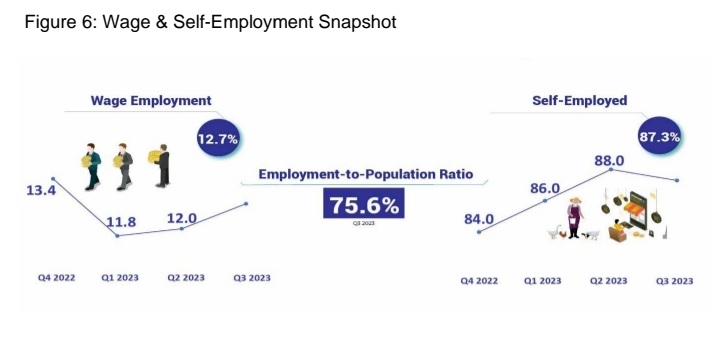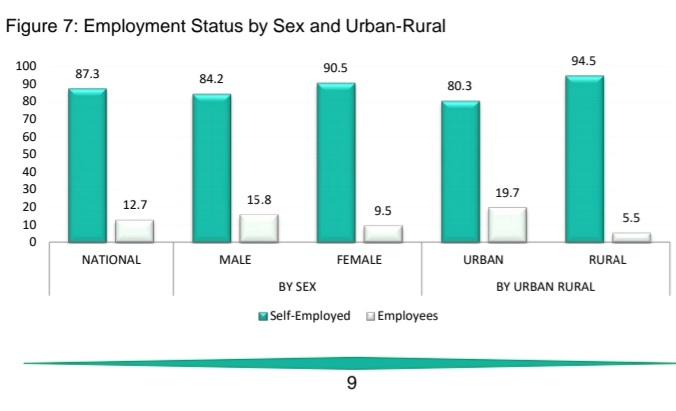▪︎Cover image: Doris Uzoka-Anite, Minister of Industry, Trade and Investment
The latest Nigeria Labour Force Statistics Report Quarter 3,2023, showed that 90.5 percent of women are engaged as self-employed while 84.2 percent of men were self-employed.
The reports, released today, by the National Bureau of Statistics (NBS), was funded by the World Bank and the International Labour Organization ( ILO).
In the findings, the statistics body revealed that in Q3 2023, 87. 3 percent of employed Nigerians were primarily self-employed with the remaining 12.7 percent being primarily engaged in salary jobs.
The NBS, in the Wage & Self-Employment Snapshot, said that paid employment declines from 13. 4 percent in Q 4 2022 to 11.8 percent Q1 2023 ; it went up to 12.0 percent in Q2 2023 and peaks at 12.7% Q3 2023.
Connverely, as at Q4 2022, 84.0 percent Nigerians were in Self-Employment; the figure surged to 86.0 percent in Q1 2023; 88.0 percent in Q2 2023 and further soared to 87.3 percent in Q3 2023.
” The unemployment rate increased significantly in Q3 2023 at 5.0%. This is an increase of 0.8% from Q2 2023.”
Disaggregation By Sex
Said the NBS statisticians: ” 90.5 percent of women were engaged as self-employed while 84.2 percent of men were self-employed.”
It said 80.3 percent of employed people in urban areas were self-employed this is lower when compared with 94.5 percent of employed people in rural areas.
On informal employment in Nigeria, NBS said : ” The share of employed persons in informal employment was 92.3% in Q3 2023 a reduction of 0.4% when compared to 92.7% in the previous quarter.
The rate of women in informal employment is
significantly higher than that of men.
The rate of informal employment among people living in rural areas was 97.2% while the urban informality rate was estimated at 87.5%. Females are more in informal employment than males.”
Other highlights of the reports are that the labour force participation rate among the working-age population declined to 79.5% in Q3 2023 compared to 80.4% in Q2 2023.
• The employment-to-population ratio was 75.6% in Q3 2023 with a decrease of 1.5% compared to a ratio of Q2 2023.


• The combined rate of unemployment and time-related underemployment as a share of the labour force population increased to 17.3% in Q3 2023 from 15.5% in Q2 2023.
• The unemployment rate increased significantly in Q3 2023 at 5.0%. This is an increase of 0.8% from Q2 2023.
• The rate of unemployment among persons with post-secondary education was 7.8% in Q3 2023
• The unemployment rate among youth aged (15-24 years) was 8.6% in Q3 2023. Increase of 1.4% compared to Q2 2023.
• The unemployment rate in urban areas was 6.0% in Q3 2023, a slight increase of 0.1% from Q2 2023.
• Time-related underemployment in Q3 2023 was 12.3%, showing a slight increase of 0.5% from the rate recorded in Q2 2023. This shows an increase of 1.4% compared to the rate in Q4 2022.
• 4.1% of the working-age population was in subsistence agriculture in Q3 2023.
• Informal employment rate in Q3 2023 was 92.3%, while Q2 2023 was 92.7%.
Percentage of youth Not in Employment, Education or Training (NEET Rate) was 13.7% in Q3 2023

